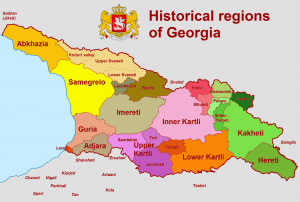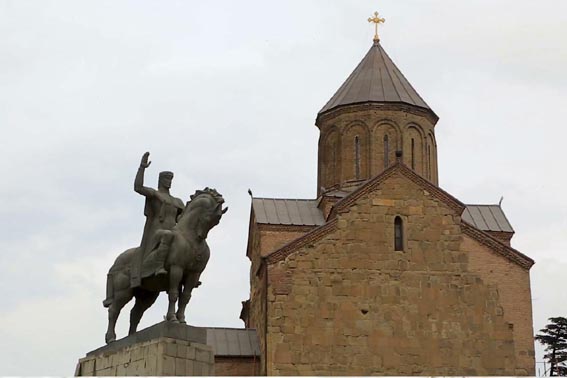Georgia is situated at the junction of two continents: Europe and Asia, and occupies 69.500 sq km. the north Georgia is bordered by the Caucasus Mountain Range and the west by the Black Sea. The country’s population is about five million people.
Georgia has a rich variety of natural features including the eternal snows of the Caucasus which lie quite close to the caressing warm waves of the Black Sea and its humid subtropics. In other regions, lush Alpine meadows give way to plains and highlands. The valleys of Georgia sparkle with the emerald verdure of Kakhetian and Kartlian orchards and vineyards.
A tourist arriving in Georgia could find himself living in all four seasons of the year at once within a short span of time. Such a diversity of natural conditions is due to the mountainous terrain. Over 80% of Georgia is covered by mountains and hills protecting Georgia from the cold airflow from the North. This explains the fact that the climate here is mild.
The Georgian language is one of the oldest living languages in the world. Georgian script dates from IV-III centuries B.C. (as mentioned in the Assyrian manuscript ”The Book of Peoples & Countries’’).
In ancient Greek mythology, Georgia is known as the land of the Golden Fleece, Princess Medea and rebellious Prometheus. In antiquity it was the easternmost pocket of Mediterranean cultural influence. Having adopted Christianity in 337, Georgia became one of the first countries where the new religion was elevated to the rank of State authority.
Proof of Georgia’s ancient culture is evident in architectural monuments, murals, paintings and sculptures: the caves of Vardzia, Upliszikhe, and David-Gareji; the churches Svetitskhoveli, Alaverdi, and Jvari; the towers of Svaneti and Kakheti, as well as remarkable works of ecclesiastical and secular literature crowned by Shota Rustaveli’s poem ” Knight in the Panther’s Skin,” written in the XII century and translated into many languages.
GENERAL INFORMATION
 Area: 69.700 km 2.
Area: 69.700 km 2.
Population: 5,399,000 (1999), 56% residential, 44% rural.
Capital: Tbilisi, population – 1,253,000; Georgian – 70%, Armenian – 8%, Azeri – 6%, Russian 5%, Greek – 2%.
Main towns and populations: Kutaisi – (233,100), Rustavi- (150,000), Batumi- (130,100), Gori – (68,000), Poti – (50,900).
Head of State and Government: President Mikheil Saakashvili since 2004.
Language: The official language is Georgian, the only language in the Iberia Caucasian family written in ancient script, with its own unique alphabet. Russian, Ossetian, Mingrelian, Armenian, Azeri and Abkhazian are also spoken.
Religion: Christian Orthodox Church. Minor religious groups include Shiite and Sunni Muslims, Armenian Gregorians, Catholics, Baptists, and Jews.
Geography: Georgia is a mountainous country bordered by the Black Sea from the west, which forms a 315km. (205 miles long) coastline. The country is crossed by the ranges of the Greater Caucasus (highest peaks: Mt. Shkhara, 5068m., Mt. Kazbek, 5047m.). The inter-mountain depression south of the Greater Caucasus encompasses the Kolkheti Lowland, Inner Kartli, Lower Kartli and the Alazani Plains. Still further south there are the Minor Caucasus ranges of medium height (Meskheti, Shavsheti and other ranges), reaching 2850 m. The southernmost area of the country is covered by the volcanic South Georgian Upland (Mt. Didi Abuli, 3301 m. at the highest peak). The Greater Caucasus and the South Georgian Upland join at the Likhi Range, which at the same time divide Georgia into two contrasting climatic zones.
West and East Georgia are enclosed by high valleys, wide basins, health spas with famous mineral waters, caves and waterfalls. Georgia represents a land of varied landscapes and striking beauty.
In different regions of Georgia climate varies from warm, humid, subtropical Black Sea coast to cold, wet, alpine climate of the High Caucasus and the arid steppes in the East. The Greater Caucasus and the South Georgian Upland are joined by the Likhi Range and divide Georgia into two contrasting climatic zones: West and East Georgia. At the same time the Greater Caucasus range moderates local climate by serving as a barrier against cold air from the north. The average temperature in the mountains is about of 5.7°C. In the high mountains the winter lasts for eight months with an average temperature of -15°C. It gets even colder on the high Javakheti plateau. On the coast of Adjara the temperature ranges from 5.8°C in January to 23.8°C in August. In East Georgia the temperature ranges from 0.5° C in January to 23°C in August.
Kakheti (East Georgia) is a considerably hot part of the country. In summer the temperature varies from + 30° to +40°C and in winter from -8° to +5°C.
Main Rivers: Mtkvari (Kura) – 1515 km. (351 km. in Georgia), Alazani – 407km. (390 km. in Georgia), Rioni (333 km.).
Main Lakes: Paravani (38 sq. km., depth – 3.3m, 2073m. above sea level), Tabatskuri (14 sq. km., depth – 40m., 2000m. above sea level), Keli (1,3 sq. km. depth – 63m., 2900m. above sea level), Ritsa (1.5 sq. km. depth – 101m., 880m. above sea level).
Time: GMT + 3.
Electricity: 220 volts AC, 50 Hz. European-type, dual prong plugs are used.
Telephone: IDD is available. Country code: 995. Outgoing international codes: 8-07 or 8-10, 8-18
Mobile telephone: GSM 900 and 1800 networks. Main operators include Geocell Ltd. (www.geocell.com.ge) and Magti Com (www.magtigsm.com). Coverage extends nearly all over the country, except for a few lowland areas and some high mountain regions.
TBS Airport: 20 km. from Tbilisi center.

 Deutsch
Deutsch Русский
Русский